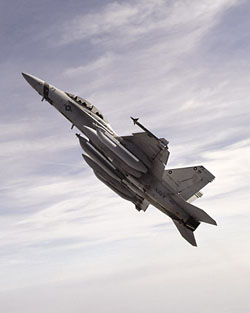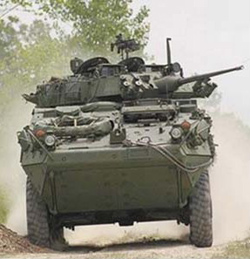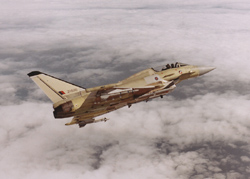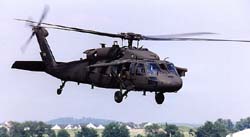Page 1
Daily News
By Gail Helmer
| Send Us News | Archives | Main |
Friday November 16, 2001
PC News
- Edge Of Chaos Jacksons Yard Patch
- Ghost Recon Woes
- Boeing Successfully Demonstrates EA-18 Airborne Electronic Attack
- Northrop Grumman Chassis And Turret Control Systems For Lav III
- Eurofighter DA4 Re-Enters Flight Test Programme
- Work Begins On BLACK HAWK Upgrade Programme
- Air Strikes Claim Taliban, Al Qaeda Leaders
- Taliban, Al Qaeda Hurt, But Not Destroyed
- Joint Force Concept Comes Of Age In Afghanistan
Edge Of Chaos Jacksons Yard Patch
This unofficial patch fixes a specific problem in Act 2 of Edge Of Chaos, where a character called Frederick Jackson at a station called Jackson's Yard will not speak to you, which can prevent progress through the game. The patch does not affect any other part of the game, and does not change the game's version number. If you don't have this problem you do not need this patch! The patch requires Edge Of Chaos version F14.6, and supports all language versions. Download Patch
Ghost Recon Woes
It has come to our attention that a multitude of people are having problems with the newest Tom Clancy title "Ghost Recon". The biggest complaint is that the game will not install. Those lucky enough to install the game are experiencing every problem from, desktop crashes, video card incompatibility, windows compatablility, multiplayer issues, and much more. No word yet from Ubi Soft about a patch, but we will keep you posted. For more on "Ghost Recon" click here
Military News
Boeing Successfully Demonstrates EA-18 Airborne Electronic Attack
Boeing today successfully completed an initial flight demonstration of its EA-18 Airborne Electronic Attack (AEA) concept aircraft. The test used an F/A-18F Super Hornet to carry three ALQ-99 jamming pods and two fuel tanks while measuring noise and vibration data and assessing aircraft flying qualities.
The EA-18 is one of the platforms under consideration in a Department of Defense analysis of alternatives to replace the EA-6B Prowler electronic warfare aircraft. The U.S. Navy has an operational need to start replacing the Prowler by 2008.
"The EA-18 will perform full-spectrum electronic surveillance and electronic attack of enemy threat radars and communications nets," said Paul Summers, director for Boeing's F/A-18 derivative programs. "The EA-18 leverages the U.S. Navy's investment in the F/A-18E/F Super Hornet platform and Northrop Grumman's Improved Capability III radar receiver system, which represents a significantly reduced risk approach over other unproven platforms and systems."
A derivative of the two-seat F/A-18F Super Hornet - a platform which is in production today - the EA-18 is a highly flexible design that enables the warfighter to perform a broad range of tactical missions, operating from either the deck of an aircraft carrier or land-based fields.
The EA-18 is 99 percent common with the Super Hornet and would be expected to significantly reduce support and training costs for the U.S. Navy.
The EA-18 is the result of an engineering design, development and test effort that began in late 1993. This effort has included avionics and aircraft conceptual design, engineering analysis, high- and low-speed wind tunnel testing, electromagnetic interference/compatibility laboratory testing, antenna range testing and extensive crew-vehicle interface development.
The combination of a validated design, proven platform and proven electronics positions the EA-18 program to begin a system development and demonstration phase as early as 2003.
Northrop Grumman Chassis And Turret Control Systems For Lav III
Northrop Grumman Systems Canada will supply electronic chassis and turret control systems to GM Defense in contracts valued at Can$52 million. The multi-year orders will provide electronic assemblies for major new Light Armoured Vehicle (LAV) programmes for the US Army, the Australian Army and the New Zealand Army.
GM's contract with the US Army calls for the delivery of 2,131 LAV III model vehicles over the next seven years. Partnered with General Dynamics Land Systems, GM will re-equip the US Army Brigade Combat Teams with a new generation of lighter, faster and more versatile armoured vehicles. The contract is valued at 6 billion Canadian dollars over seven years. Starting in 2002, GM will also begin to fill major new armoured vehicle programmes for both the Australian Army and the New Zealand Army.
"Northrop Grumman Systems Canada has enjoyed a close relationship with General Motors Defense dating back to 1996 when we started work on the Canadian APC programme," said Richard Ackerman, vice president of Marketing, Contracts and Special Projects for Northrop Grumman. "We are very excited with this contract announcement that cements our relationship by extending it into new areas such as the US Army's Brigade Combat Team and similar programmes in Australia and New Zealand. "
With a top speed of 100 km/h (60 mph) and a cruising range of 330 kilometres (200 miles), GM-built LAVs have seen military and peacekeeping service in Cyprus, Panama, Somalia, Bosnia, and, in the hands of the US Marine Corps, in Operation Desert Storm in Iraq. Most recently, GM Defense vehicles have provided critical military support for Canadian Forces peacekeeping forces in both Kosovo and Eritrea.
Eurofighter DA4 Re-Enters Flight Test Programme
Eurofighter DA4, one of the two development aircraft based at BAE SYSTEMS Warton, has recently re-entered the flight test programme following an extensive period on lay-up.
During the lay-up the aircraft underwent significant upgrades to the Avionics and Power generation systems, as well as completing the first phase of the Defensive Aids Sub System (DASS) ground trials in the Electronic Warfare test facility at the Warton facility. The trial a major risk reduction activity for the standard of aircraft beyond Initial Operational Clearance.
DA4's first flight back in the programme concentrated on 'shaking down' all the major systems of the aircraft, with particular emphasis on the engines, radar, Advanced Medium-Range Air-to-Air Missile (AMRAAM) integration and Ground Proximity Warning System (GPWS).
Over the coming weeks the aircraft will be involved in priority flight trials to support the initial clearance into service of the aircraft next year. In particular it will concentrate on assessment of the weapon system as a whole including AMRAAM and Advanced Short-Range Air-to-Air Missile (ASRAAM) integration with the radar and GPWS. In the medium term a first flight assessment of the DASS, including on-range flight trials will be carried out at RAF Spadeadam in Northumberland, the RAF's Electronic Warfare test range.
The AMRAAM flight trials will lead up to the first fully guided firing of an AMRAAM against an airborne target, at the Benbecula deep-sea range off North West Scotland early in the new year.
Work Begins On BLACK HAWK Upgrade Programme
Evaluation of the first three US Army BLACK HAWKs, slated for upgrade to the new UH-60M configuration, has begun with Sikorsky Support Services Inc. (SSSI), a subsidiary of Sikorsky Aircraft Corp. The two UH-60As and one UH-60L are the first aircraft officially inducted into the Army's comprehensive BLACK HAWK recapitalisation program, scheduled to overhaul 1,200 aircraft over 25 years.
The rebuilt aircraft are to have improved payload, new digital cockpit displays, a strengthened fuselage, new composite spar wide-chord blades, and more powerful engines. The recapitalised UH-60 aircraft will have an additional 20 years of service life with lower maintenance costs than the current fleet. In addition, the UH-60M will replace the UH-60L as the standard configuration for all new US Army BLACK HAWK production aircraft, beginning in 2007.
"The UH-60M programme is of great importance long term to both the US Army and Sikorsky Aircraft," said company President Dean Borgman. "It will significantly improve fleet performance while also reducing the Army's operating and support costs. "
In May, Sikorsky signed a $219.7 million research, development, test and evaluation contract to make four UH-60M test articles: three converted from the existing fleet and one new production aircraft.
SSSI will disassemble the aircraft, inspect parts, recondition the cockpit, tailcone, and tail structures. Sikorsky will install a new glass cockpit with four multi-function displays; two control display units, a modern flight control computer, a new avionics suite and a narrower instrument panel to improve chin window visibility. In addition, the aircraft will be fitted with a new cabin and transition section that uses high-speed machine frames to reduce the cost and complexity of the cabin.
The UH-60M composite spar wide-chord blade will provide 500 pounds more lift than the current UH-60L blade. The new General Electric T700-GE-701D engine currently under development by the Army will add 3 percent more shaft horsepower, which will allow 400 to 500 pounds additional payload.
The maiden flight of the first UH-60M is scheduled for 2003. After completion of the first four aircraft, work on the low rate initial production UH-60M aircraft will begin in 2004 and will eventually increase to 90 aircraft inducted per year by 2012.
Air Strikes Claim Taliban, Al Qaeda Leaders
WASHINGTON, Nov. 15, 2001 -- U.S. air strikes in Afghanistan during the past several days targeted upper- level Taliban and Al Qaeda leaders and have achieved some success, a senior DoD official said.
Pentagon spokesperson Victoria Clarke told reporters today that raids Tuesday on a building near the Afghan capital of Kabul and Wednesday on a building in Kandahar killed "some numbers" of Taliban and Al Qaeda's senior leadership. She said anti-terrorist intelligence sources provided information used to conduct the strikes.
There is "no evidence" that Taliban leader Mullah Mohammed Omar or Al Qaeda chief Osama bin Laden were present at either raid site, she noted.
Asked about the likelihood of reducing the U.S.-coalition Afghan air campaign during the upcoming Muslim observance of Ramadan, Clarke replied: "We are very sensitive to Muslim concerns about Ramadan."
However, she noted, "History has been filled with example, after example, after example of Muslims fighting during Ramadan." The terrorists, Clarke pointed out, "are not sitting back and taking a break, and, nor will we."
Eight humanitarian aid workers, including two Americans, who'd been detained by the Taliban were released yesterday, Clarke said. The eight were picked up by U.S. special operations troops southwest of Kabul and flown out of the country. They are to undergo medical exams and debriefings, perhaps in Germany, she said.
Taliban, Al Qaeda Hurt, But Not Destroyed
WASHINGTON, Nov. 15, 2001 -- The four-star general in charge of U.S. military actions in Afghanistan told reporters today that Taliban militia and Al Qaeda forces have given up considerable ground in recent days, but they're "not destroyed" and the battle isn't over.
"What is important to us is the destruction of the Al Qaeda network, a terrorist network with global reach, so we remain fixed on that mission, as well as (the destruction of the) Taliban regime in Afghanistan," Army Gen. Tommy Franks said at a Pentagon press briefing together with Defense Secretary Donald H. Rumsfeld.
"The Taliban is not destroyed as an effective fighting force in Afghanistan," Franks emphasized, adding, "We'll continue to do our best to eliminate both Taliban and Al Qaeda troops."
Both men estimated that anti-terrorist forces now occupy 50 percent to 60 percent of the country since Taliban and Al Qaeda troops began a major retreat that began Nov. 9 from the northern Afghan city of Mazar-e Sharif.
The humanitarian assistance situation in Afghanistan "gets better every day," Franks said. In the past three days, he remarked, more than 6,500 metric tons of humanitarian supplies have been delivered to the Afghan people. Support to humanitarian relief agencies working in Afghanistan will continue, he added.
U.S. and coalition forces have the initiative and intend to keep it, he noted.
Modest numbers of U.S. special operations forces continue to work with anti-Taliban tribes in southern Afghanistan, Franks noted, adding that the future use of more conventional U.S. ground forces in the country "remains an option." The rules of engagement for U.S. forces should they come into contact with threatening Taliban or Al Qaeda troops are to "destroy those forces," he said.
Rumsfeld noted that Al Qaeda leader Osama bin Laden may try to flee to another country by helicopter, or "on a donkey, a burro, a mule, a horse" or in a truck. Afghanistan is about the size of Texas and is noted for its porous borders, Rumsfeld said. "It is not (like) a bottle that you can cork," he remarked. "It's a large country with a lot of borders. One has to be realistic. I think we'll find him, either there or in some other country."
U.S. and coalition military actions in Afghanistan will cease upon the unconditional surrender of all Taliban and Al Qaeda forces there, Rumsfeld emphasized.
Earlier in the day, Deputy Defense Secretary Paul D. Wolfowitz accompanied New York City Mayor-elect Michael R. Bloomberg on a tour of the Pentagon's west wall, damaged by the Sept. 11 terrorist-hijacked airliner attack. Almost 190 people, 125 in the Pentagon and 64 aboard the plane, died in the crash. More than 5,000 are feared dead from the two New York World Trade Center attacks, another 45 people died aboard a terrorist hijacked airliner that crashed in Somerset County, Pa.
Bloomberg told Pentagon reporters after the tour that "New York has to understand that other parts of the country also are subject to terrorism."
"Our hearts go out to the people who lost their lives, both in the airplane and on the ground here," Bloomberg said. "It is very tragic ... we just wanted people who live here and work here to understand that we are with them in the same sense that we need them to be with us in New York."
"We are all in this together," Wolfowitz said in agreement. "We have Americans out in Afghanistan risking their lives, some of them losing their lives, trying to end this threat. ... Bin Laden is going to join that list of tyrants who've underestimated the strength and will of the American people." Pentagon spokeswoman Victoria Clarke said earlier in the day that U.S. and coalition forces flew 136 air sorties on Nov. 14. The missions, she noted, were directed against nine planned targets with a focus on Taliban and Al Qaeda command-and-control sites, and cave and tunnel complexes. She said three C-17 aircraft dropped more than 36,000 Humanitarian Daily Ration packs, wheat, and blankets to needy Afghans yesterday.
Joint Force Concept Comes Of Age In Afghanistan
The media have done a good job of covering the war in Afghanistan, but the coverage contains only "snapshots" of the military action, said Air Force Gen. Richard B. Myers. The press could not cover the broader, more important, issue.
Myers, chairman of the Joint Chiefs of Staff, told attendees at the Fletcher Conference here that the real story was the way Army Gen. Tommy Franks and the entire US Central Command team have choreographed and executed the overall effort.
The Fletcher Conference is jointly sponsored by the Institute for Foreign Policy Analysis and the Army. The theme this year is "National Security for a New Era."
"In my view, General Franks is an absolutely outstanding commander and leader, and he has effectively called on the strengths and unique capabilities that the different services bring to this fight," Myers said. Franks has bonded the services together and created the synergy of a joint effort. "This is really what joint warfighting is all about, and why joint warfighting is so important," Myers said.
He explained that the best way to make coordination smoother is to field a joint force. This has to include interoperable weapon systems and interoperable command, control, communications, computers and intelligence, surveillance and reconnaissance. "If we're going to focus on anything in my tenure, we've got to focus on better C4ISR in a way to give our operational commanders the tools they need to make decisions," Myers said.
Taking the lessons learned from Kosovo, US military forces have developed much better interoperability, "particularly for fleeting targets," he said.
"In some cases, we've been forced to cobble together 'work- arounds' because some of our existing systems do not 'plug and play' in this joint war fight," Myers said. One example was the B-2 bomber's use in Operation Enduring Freedom. The B-2s, based in Whiteman Air Force Base, Mo., fly almost two days to hit targets in Afghanistan.
"If it takes you that long to get to the target, you're going to have to have updates along the way. The threat can change, the targets can change -- and they did," he said. "You would think that a modern aircraft that cost as much as the B-2 would have this interoperability built in, but it doesn't.
"They had a special antenna with a special communications set up that came to a laptop, which one of the pilots would hold on his lap. That's how they did their communications and got their updates on the targets. Effective, but a lot cruder than we need ...."
Weapons systems must be designed up front with interoperability within the US military and with coalition allies in mind. "We hear this term 'born joint,' and that's certainly what we'd like to do," he said. He said the military would not field new systems without this interoperability built in. The military will also upgrade 'legacy systems' to ensure an effective joint force.
In another example, F-22s have superior sensor avionics that communicate well among F-22s. Unfortunately, Myers said, they cannot communicate with other systems. The Air Force is working to fix this before fielding the craft. "If a system does not contribute to the joint fight, then it is probably not right," he said.
Policies and procedures are also being changed to foster joint warfighting capabilities. Myers said he has high hopes for standing joint task force headquarters that would assigned to every commander-in-chief. These fully staffed, ready-to-go headquarters would have robust command and control suites, be fully versed on theater activities and be able to interact with subordinate commands.
"What we're really trying to do here is dissipate, as much as possible, the fog of war to allow timely, decisive action on the part of our commanders," Myers said.
| Send Us News | Archives | Main |



